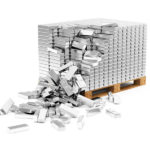Congress passes law to curb manufacturing of fake coins
THANK YOU FOR POSTING A REVIEW!
Your review was sent successfully and is now waiting for our staff to publish it.
(December 25, 2014 - by Geoff Earle, New York Post)
WASHINGTON – Fake antique gold and silver US coins – many purporting to be more than 200 years old — are flooding the US resale market from China, and Congress just passed a law to do something about it.
The legislation breezed through the Senate in the final days of the session, and was one of the last bills President Obama signed into law before jetting to Hawaii.
With the market for rare and antique coins booming – and the biggest coin markets in New York — forgers have mastered the art of creating nearly exact replicas of valuable collectors’ items, with enough precision to fool the experts.
Sometimes forgers manufacture the fakes out of real gold or silver. Other times they insert less precious materials like titanium inside the coin, but manage to duplicate the exact weight of precious metals.
“They’re very deceptive,” said former Rep. Jimmy Hayes (R-La.), a lobbyist who helped push through the bill. “I assure you there’s no way to tell if it’s good or not. You’ll never suspect.”
Hayes said a typical Chinese forger might spend $30 making a fake rare coin that can go for $1,200.
Hayes knows something about the value of real antique coins. He sold his own childhood coin collection for $1.2 million to finance a run for Congress in the 1990. He says now it would be worth about $60 million.
The new law makes it illegal to sell imitation coins unless they are clearly marked as a “copy.” It makes it a crime to aid the manufacturer, importer, or seller of forged items.
And if special collection certificates get faked as part of a scheme, the owner of the trademarks on the certificates are entitled to seek damages.
Individuals can file civil lawsuits against sellers of fake coins, buttons, and posters to try to recoup costs.
New York is the center of the trade in rare coins. Stores like Heritage Auctions and Stack’s Bowers on W. 57th St. hold major monthly trade shows where the items change hands.
The most expensive coin to sell at auction was a 1794 Flowing Hair silver dollar that went for $10 million at Stack’s in 2013.
The fraudsters are taking a toll on pawn shops. The average mom-and-pop dealer loses $3,500-$4,500 when the fall for fake coins, said Doug Davis, a longtime police officer who runs the Numismatic Crime Information Center.
A group called the Gold and Silver PAC spent some coin of its own to help get its priority bill across the finish line. The PAC made $72,000 in campaign contributions in 2013 and 2014, according to the Center for Responsive Politics web site.
Recipients from the last two election cycles included sponsor G.K. Butterfield (D-N.C.), who got $5,000, Sen. Ed Markey (D-Mass.), who got $10,000, Rep. Steve Scalise (R-La.), who got $7,000, and Rep. Henry Waxman (D-Calif.) got $5,000.
According to the PAC’s web site: “After the bill had been stalled in the Senate for over a year, Legislative Consultant Jimmy Hayes and Gold & Silver PAC Chairman Barry Stuppler met Barry’s Congressman, Henry Waxman (D-CA) to ask Rep. Waxman to help get this bill moving in the Senate.”
“With Waxman’s efforts combined with our friends in the Senate on the Commerce Committee did the trick. Two months later the bill was passed without any opposition.”
Cops are on the lookout for a man who has been passing fake coins in a forged coin spree across Colorado, Iowa, Missouri, Kansas, and other states.
He pedaled a rare 1822 dime and what he said was an 1893 “Morgan” silver dollar to a Colorado coin shop in November, according to an alert circulated to law enforcement and shops around the country.
“We’ve probably got six or seven offenses related to him. He’s buying them from some Internet site I’m sure — They’re all Chinese fakes – counterfeits,” Davis, of the coin information center, told the Post.
-
Silver Remains On The Defensive Below $27.50 On Easing Middle East Tensions By
Mint State Gold
April 24 2024
-
China's Demand for Gold Is Unstoppable As Consumers, Investors, And The Central Bank Fuel A Record-Breaking Price Surge By
Mint State Gold
April 22 2024






